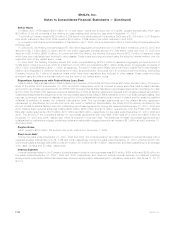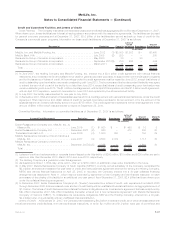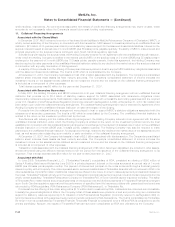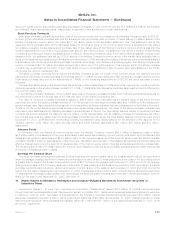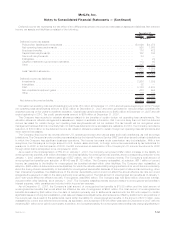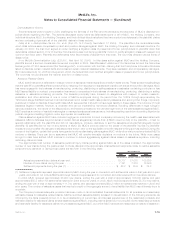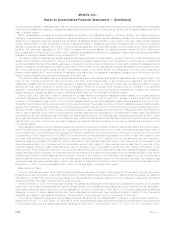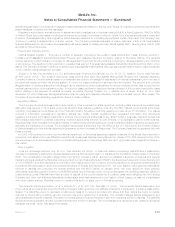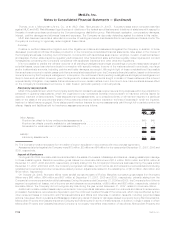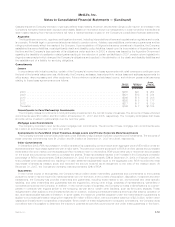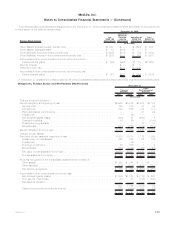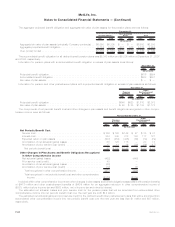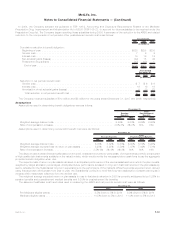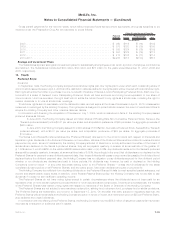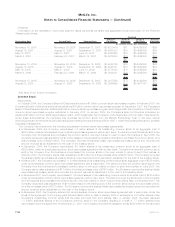MetLife 2007 Annual Report Download - page 152
Download and view the complete annual report
Please find page 152 of the 2007 MetLife annual report below. You can navigate through the pages in the report by either clicking on the pages listed below, or by using the keyword search tool below to find specific information within the annual report.and (iii) the legal defense costs associated with the foregoing claims. Significant assumptions underlying MLIC’s analysis of the adequacy
of its recorded liability with respect to asbestos litigation include: (i) the number of future claims; (ii) the cost to resolve claims; and (iii) the
cost to defend claims.
MLIC reevaluates on a quarterly and annual basis its exposure from asbestos litigation, including studying its claims experience,
reviewing external literature regarding asbestos claims experience in the United States, assessing relevant trends impacting asbestos
liability and considering numerous variables that can affect its asbestos liability exposure on an overall or per claim basis. These variables
include bankruptcies of other companies involved in asbestos litigation, legislative and judicial developments, the number of pending
claims involving serious disease, the number of new claims filed against it and other defendants, and the jurisdictions in which claims are
pending. As previously disclosed, in 2002 MLIC increased its recorded liability for asbestos-related claims by $402 million from
approximately $820 million to $1,225 million. MLIC regularly reevaluates its exposure from asbestos litigation and has updated its liability
analysis for asbestos-related claims through December 31, 2007.
The ability of MLIC to estimate its ultimate asbestos exposure is subject to considerable uncertainty, and the conditions impacting its
liability can be dynamic and subject to change. The availability of reliable data is limited and it is difficult to predict with any certainty the
numerous variables that can affect liability estimates, including the number of future claims, the cost to resolve claims, the disease mix and
severity of disease in pending and future claims, the impact of the number of new claims filed in a particular jurisdiction and variations in the
law in the jurisdictions in which claims are filed, the possible impact of tort reform efforts, the willingness of courts to allow plaintiffs to
pursue claims against MLIC when exposure to asbestos took place after the dangers of asbestos exposure were well known, and the
impact of any possible future adverse verdicts and their amounts.
The ability to make estimates regarding ultimate asbestos exposure declines significantly as the estimates relate to years further in the
future. In the Company’s judgment, there is a future point after which losses cease to be probable and reasonably estimable. It is
reasonably possible that the Company’s total exposure to asbestos claims may be materially greater than the asbestos liability currently
accrued and that future charges to income may be necessary. While the potential future charges could be material in the particular
quarterly or annual periods in which they are recorded, based on information currently known by management, management does not
believe any such charges are likely to have a material adverse effect on the Company’s financial position.
During 1998, MLIC paid $878 million in premiums for excess insurance policies for asbestos-related claims. The excess insurance
policies for asbestos-related claims provide for recovery of losses up to $1.5 billion, which is in excess of a $400 million self-insured
retention. The Company’s initial option to commute the excess insurance policies for asbestos-related claims arises at the end of 2008.
Thereafter, the Company will have a commutation right every five years. The excess insurance policies for asbestos-related claims are also
subject to annual and per claim sublimits. Amounts exceeding the sublimits during 2007, 2006 and 2005 were approximately $16 million,
$8 million and $0, respectively. The Company continues to study per claim averages, and there can be no assurance as to the number and
cost of claims resolved in the future, including related defense costs, and the applicability of the sublimits to these costs. Amounts are
recoverable under the policies annually with respect to claims paid during the prior calendar year. Although amounts paid by MLIC in any
given year that may be recoverable in the next calendar year under the policies will be reflected as a reduction in the Company’s operating
cash flows for the year in which they are paid, management believes that the payments will not have a material adverse effect on the
Company’s liquidity.
Each asbestos-related policy contains an experience fund and a reference fund that provide for payments to MLIC at the commutation
date if the reference fund is greater than zero at commutation or pro rata reductions from time to time in the loss reimbursements to MLIC if
the cumulative return on the reference fund is less than the return specified in the experience fund. The return in the reference fund is tied
to performance of the Standard & Poor’s (“S&P”) 500 Index and the Lehman Brothers Aggregate Bond Index. A claim with respect to the
prior year was made under the excess insurance policies in each year from 2003 through 2007 for the amounts paid with respect to
asbestos litigation in excess of the retention. As the performance of the indices impacts the return in the reference fund, it is possible that
loss reimbursements to the Company and the recoverable amount with respect to later periods may be less than the amount of the
recorded losses. Foregone loss reimbursements may be recovered upon commutation depending upon future performance of the
reference fund. If at some point in the future, the Company believes the liability for probable and reasonably estimable losses for asbestos-
related claims should be increased, an expense would be recorded and the insurance recoverable would be adjusted subject to the terms,
conditions and limits of the excess insurance policies. Portions of the change in the insurance recoverable would be recorded as a
deferred gain and amortized into income over the estimated remaining settlement period of the insurance policies. The foregone loss
reimbursements were approximately $56.1 million with respect to claims for the period of 2002 through 2006 and are estimated, as of
December 31, 2007, to be approximately $69.1 million in the aggregate, including future years.
Sales Practices Claims
Over the past several years, MLIC; New England Mutual Life Insurance Company, New England Life Insurance Company and New
England Securities Corporation (collectively “New England”); GALIC; Walnut Street Securities, Inc. (“Walnut Street Securities”) and MetLife
Securities, Inc. (“MSI”) have faced numerous claims, including class action lawsuits, alleging improper marketing or sales of individual life
insurance policies, annuities, mutual funds or other products.
As of December 31, 2007, there were approximately 130 sales practices litigation matters pending against the Company. The Company
continues to vigorously defend against the claims in these matters. Some sales practices claims have been resolved through settlement.
Other sales practices claims have been won by dispositive motions or have gone to trial. Most of the current cases seek substantial
damages, including in some cases punitive and treble damages and attorneys’ fees. Additional litigation relating to the Company’s
marketing and sales of individual life insurance, mutual funds or other products may be commenced in the future.
Two putative class action lawsuits involving sales practices claims are pending against MLIC in Canada. In Jacynthe Evoy-Larouche v.
Metropolitan Life Ins. Co. (Que. Super. Ct., filed March 1998), plaintiff alleges misrepresentations regarding dividends and future payments
for life insurance policies and seeks unspecified damages. In Ace Quan v. Metropolitan Life Ins. Co. (Ont. Gen. Div., filed April 1997),
F-56 MetLife, Inc.
MetLife, Inc.
Notes to Consolidated Financial Statements — (Continued)


